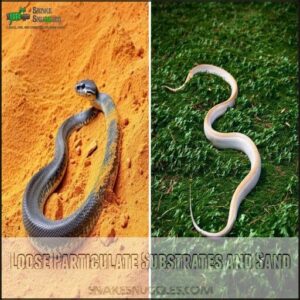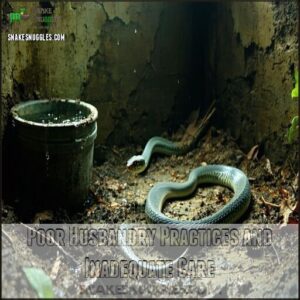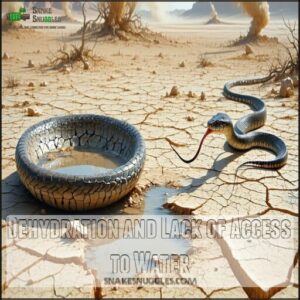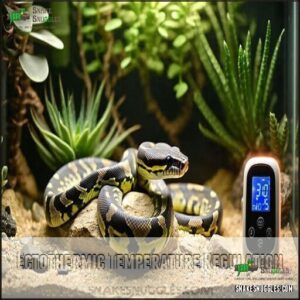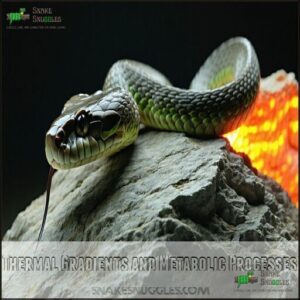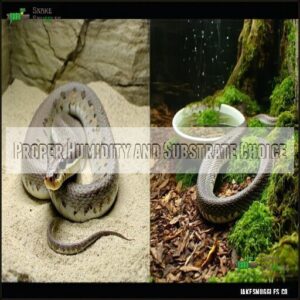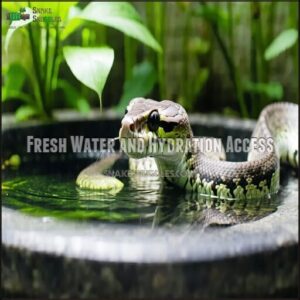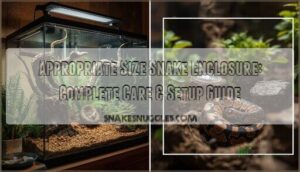This site is supported by our readers. We may earn a commission, at no cost to you, if you purchase through links.
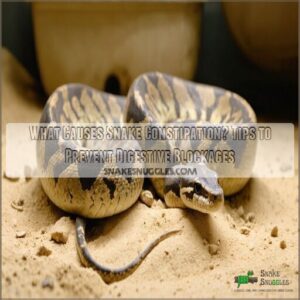
Dehydration is a big culprit—snakes need proper hydration to keep things moving. Temperature and humidity also play a role since cold or overly dry conditions can mess up digestion.
Overfeeding or feeding the wrong prey size can cause blockages, and sometimes snakes ingest substrates like sand or bark, which don’t easily pass.
Health issues, like infections or impaction, might also be involved. It’s vital to closely monitor their environment and habits because, let’s face it, a constipated snake isn’t a happy one, and proper care is essential.
Table Of Contents
- Key Takeaways
- Snake Constipation Causes
- What Causes Snake Constipation
- Common Causes of Constipation
- Snake Digestive Health Factors
- Preventing Snake Constipation
- Frequently Asked Questions (FAQs)
- Why is my snake constipated?
- What are some of the main causes of constipation?
- How to prevent constipation in snakes?
- Why do snakes have blocked bowels?
- How do you know if a snake is constipated?
- What happens if a snake doesn’t poop?
- Can stress cause constipation in snakes?
- How does age affect snake digestion?
- Are certain snake species prone to constipation?
- Do medications impact snake bowel movements?
- Conclusion
Key Takeaways
- Keep your snake hydrated with constant access to clean water, proper humidity levels, and occasional warm soaks to prevent hard stools and blockages.
- Avoid overfeeding by sticking to the correct prey size and feeding schedule to prevent digestive strain and constipation.
- Maintain proper enclosure temperature and smooth digestion to support smooth digestion and avoid environmental-related issues.
- Use safe substrates like reptile carpet or cypress mulch to prevent accidental ingestion and impaction.
Snake Constipation Causes
Snake constipation happens when factors like dehydration, improper diet, or environmental issues disrupt their digestion.
By understanding these causes, you can take steps to keep your scaly companion healthy and comfortable.
Overfeeding and Digestive Issues
Overfeeding is a top culprit behind snake constipation causes.
Overfeeding overwhelms your snake’s digestion, leading to blockages and constipation—stick to proper portions and feeding schedules.
Too much food overwhelms their digestive systems, leading to undigested food and constipation.
Watch out for:
- Prey Size: Too large prey strains digestion.
- Feeding Frequency: Avoid excessive meals.
- Obesity Risks: Extra weight slows digestion.
- Digestive Strain: Overfeeding causes blockages.
Stick to an appropriate schedule and portion.
Inadequate Hydration and Dehydration
Dehydration is a leading cause of snake constipation.
Stay ahead of dehydration—hydrated snakes stay healthy, shed smoothly, and avoid constipation troubles while enjoying optimal digestion.
Without proper hydration, feces harden, blocking the digestive tract. Make certain constant water access, proper humidity levels, and soak therapy for hydration.
Dehydration can worsen shedding issues and urate formation, adding to snake hydration problems.
| Problem | Impact | Solution |
|---|---|---|
| Low Humidity Levels | Dry feces, constipation | Increase enclosure humidity |
| Limited Water Access | Dehydration | Provide fresh water daily |
| No Soak Therapy | Difficult defecation | Use warm water soaks |
Inappropriate Food Items and Substrate Ingestion
Feeding prey that’s too large or has excessive bone content can cause undigested meals.
While substrate ingestion in snakes—like sand or coconut coir—leads to blockages, foreign objects, such as bedding or uneaten prey parts, risk foreign body obstruction.
Stick to proper prey size and safe substrate types to avoid substrate impaction or improper snake diet issues.
Nutritional Imbalances and Gut Motility
An improper snake diet does more harm than just hunger—it disrupts digestive motility.
Without a nutritional balance, gut flora struggles, affecting enzyme production and vitamin absorption.
Feeding prey items like overly fatty rodents weakens overall digestion.
Dietary deficiencies from poor prey digestion impair snake digestion, making constipation likely.
Snakes may also experience vitamin A deficiency if their diet lacks essential nutrients.
Always prioritize prey items that promote healthy snake digestion and support gut health to prevent issues like constipation.
Environmental Factors and Temperature Gradients
Low temperatures and poor humidity levels can slow your snake’s digestion, causing constipation.
Without proper enclosure temperature and a thermal gradient, their metabolism lags.
Environmental factors like inadequate enclosure size limit movement, while poor heat sources disrupt thermoregulation.
Shedding problems linked to humidity also exacerbate issues.
Keep a balanced temperature gradient and proper humidity to support digestion and prevent blockages.
What Causes Snake Constipation
Snake constipation happens when blockages form from dehydration, improper diets, or unsuitable environments. Understanding these causes helps you prevent serious health issues in your pet.
Impaction and Blockages
Impaction in snakes often arises from substrate ingestion, inappropriate substrate types, or foreign bodies.
This can lead to intestinal obstruction and fecalith formation, causing discomfort. Watch for snake impaction symptoms like bloating and lethargy.
Severe blockages may require surgical removal.
- Avoid loose substrates like sand or gravel.
- Make certain regular hydration.
- Use appropriate substrate types.
- Monitor for intestinal blockage signs.
Foreign Objects and Indigestible Materials
Snakes sometimes eat things they shouldn’t, leading to serious issues like substrate ingestion or foreign body ingestion.
Items like gravel, plastic, or even towels aren’t digestible and can block their insides.
Foreign object and indigestible material risks grow with loose substrates.
Protect your snake by avoiding risky substrates and ensuring prey doesn’t contain sharp bones or harmful materials to prevent impaction.
Urate Plugs and Solid Masses
When urate plugs form in a snake’s cloaca, they can lead to uncomfortable blockages, known as cloacal obstruction.
Dehydration plays a major role in urate formation, causing hard urates that are tough to pass.
Left untreated, this can worsen, possibly connecting to gout.
One potential cause is improper temperature regulation, which slows metabolism.
If you notice signs of snake constipation, like bloating or fecoliths, seek veterinary intervention immediately for relief and care.
Infections and Parasites
Unlike urate plugs, infections and parasites can clog your snake’s digestion, causing serious issues.
Parasitic infections like protozoal effects and helminths obstruct intestines, while bacterial infections add to the trouble. Watch for symptoms like bloating or regurgitation.
Combat these with proper care:
- Schedule regular vet check-ups.
- Quarantine new snakes to prevent parasite spread.
- Keep enclosures spotless.
Folliculogenesis and Reproductive Issues
Egg binding and follicular stasis impact the digestive system by putting pressure on the intestines, often causing snake constipation.
Calcium deficiency and poor husbandry practices, like inadequate hydration or diet, worsen reproductive issues.
Dystocia causes further complications, while reproductive infections harm overall health.
Ensuring proper care, hydration, and a balanced diet helps mitigate these risks and supports your snake’s well-being.
Common Causes of Constipation
Constipation in snakes often stems from preventable issues like poor husbandry, dehydration, or unsuitable enclosures.
By understanding these common causes, you can create a healthier environment for your pet and minimize risks.
Loose Particulate Substrates and Sand
Small particulate substrates like sand can cause serious issues if ingested, leading to substrate impaction in snakes.
When particles block digestion, impaction severity rises, risking health. Substrate ingestion often happens accidentally during feeding.
Instead of sand, try substrate alternatives like shredded paper or cypress mulch. Regular cleaning frequency and adequate hydration impact gut health positively, reducing ingestion risks and promoting safer digestion.
Regular maintenance, including proper cleaning and ensuring adequate hydration, is crucial for the overall health of the snakes.
Low Humidity and Temperature Levels
Low humidity and improper enclosure temperature often lead to shedding problems and a metabolism slowdown, both of which cause constipation.
To prevent this:
- Maintain a proper temperature gradient in the enclosure.
- Verify humidity levels match your snake’s species needs.
- Always prioritize hydration importance by providing fresh water.
- Monitor reptile health with regular checks for effective temperature regulation.
By following these steps, you can help ensure your snake stays healthy and thrives in its environment, with proper temperature regulation being key.
Inadequate Enclosure Size and Exercise
A small enclosure limits your snake’s movement, restricting exercise and intestinal motility.
Without proper enclosure dimensions or habitat enrichment, their digestive system slows, increasing the risk of constipation.
Lack of exercise weakens their muscles, which support bowel functions.
Always make certain the enclosure size accommodates your snake’s activity needs, encouraging natural movement to prevent issues like snake constipation caused by inadequate husbandry.
For boa constrictors, proper ventilation is vital to prevent respiratory issues, which is a critical aspect of their care and can impact their overall health and wellbeing, including the risk of respiratory issues.
Poor Husbandry Practices and Inadequate Care
Inadequate husbandry can lead to snake constipation, so focus on proper care.
Dietary neglect, poor enclosure cleanliness, and irregular health monitoring are common culprits.
Stress reduction and balanced handling frequency help avoid issues.
Environmental conditions like inappropriate temperatures exacerbate problems.
Remember: consistent snake care tips and attention to reptile constipation causes guarantee your pet stays healthy and avoids preventable digestive troubles, ensuring healthy outcomes!
Dehydration and Lack of Access to Water
When water availability is overlooked, dehydration becomes a top suspect behind a snake’s digestive troubles.
Without access to fresh, clean water, issues like urate formation and hardened waste occur, making things uncomfortable.
Low humidity levels worsen shedding problems, too.
A sturdy water dish and occasional soaks provide hydration, ensuring smoother digestion and a healthier, happier snake.
Don’t skip hydration—it’s key!
Snake Digestive Health Factors
Your snake’s digestive health relies on proper temperature, humidity levels, and access to fresh water.
By creating a balanced environment and monitoring their care, you can prevent common issues like constipation.
Ectothermic Temperature Regulation
Snakes rely on external heat sources for thermoregulation, as their metabolic rate depends on habitat temperature.
If the temperature is too low, digestion efficiency drops, leading to constipation. Proper temperature control guarantees healthy basking behavior and smoother digestion.
- Tips:
- Set up a proper thermal gradient.
- Monitor habitat temperature consistently.
- Offer warm basking spots.
- Avoid drastic temperature adjustment.
- Verify heating equipment functions well.
Thermal Gradients and Metabolic Processes
A thermal gradient is critical for ectotherm digestion.
Snakes rely on basking behavior to regulate their metabolic rate, choosing warmer spots to aid digestion.
Without proper temperature gradients, digestion slows, leading to constipation.
Low temperatures can disrupt thermoregulation, causing food to remain undigested.
Always guarantee a well-balanced thermal gradient to support temperature regulation and metabolic processes for healthy digestion.
Proper Humidity and Substrate Choice
Maintaining proper humidity levels and choosing suitable substrate types are essential for your snake’s digestive and respiratory health.
Low humidity can cause dehydration, shedding issues, and even impaction. Avoid substrates like sand, which can clump internally if ingested.
Opt for safer options such as shredded paper or cypress mulch to prevent mold growth while ensuring ideal reptile constipation management.
Keep humidity balanced!
Fresh Water and Hydration Access
A clean, appropriately sized water bowl is key for hydration.
Change water frequently, as even slight contamination deters drinking. Misting benefits snakes needing higher humidity, aiding hydration and shedding.
Watch for signs like wrinkled skin or sunken eyes to recognize dehydration early. Supplemental hydration through soaks or sprays helps when water access alone isn’t enough for maintaining ideal digestive health.
Supplying the proper snake hydration products is essential.
Regular Veterinary Check-Ups and Monitoring
Checking in with a reptile vet keeps your snake’s health on track.
Regular veterinary checkups allow early detection of issues like parasites or blockages. Preventative care, including parasite screening and monitoring health trends, helps them stay comfortable and active.
A snake vet visit isn’t just for emergencies—expert advice and routine veterinary care are key to supporting long-term snake health and digestion.
Proper temperatures are essential for healthy snake digestion, which is crucial for maintaining your snake’s overall health and ensuring they remain active.
Preventing Snake Constipation
You can prevent snake constipation by ensuring proper diet, hydration, and environment. Regular handling, appropriate feeding techniques, and maintaining enclosure conditions will keep your snake’s digestion healthy.
Proper Diet and Feeding Techniques
Feeding your snake the right way is key to avoiding digestive troubles.
Always choose an appropriate prey size—one that’s no larger than your snake’s widest part. Stick to a proper feeding frequency based on their age and species.
Thawing prey items correctly prevents snake feeding issues.
For ideal nutrition, consider gut loading prey or meeting supplementation needs to balance their diet.
Choosing The Right Substrate and Environment
When selecting a substrate, prioritize reptile carpet, paper towels, or cypress mulch to reduce substrate ingestion risk.
Mimicking natural habitats improves humidity levels and digestion. Avoid loose particulate substrates like sand, which increase impaction risks for snakes.
Many owners prefer reptile carpet options for their snake enclosures.
Proper temperature gradient setups and enclosure size adjustments guarantee comfort and mobility. These changes create a healthier environment, supporting ideal digestion and overall health.
Withholding Food and Preventing Overfeeding
Avoiding overfeeding is essential for your snake’s digestive health.
Give it time to digest properly and prevent issues by focusing on these steps:
- Follow a Feeding Schedule: Offer meals based on your snake’s age, size, and species.
- Prey Size Matters: Choose prey that’s no larger than the widest part of your snake.
- Prevent Obesity: Avoid powerfeeding and stick to a balanced diet.
Regular Handling and Monitoring Health
Regular handling helps you spot subtle signs of snake health problems early, like shedding patterns or changes in behavior.
Daily observation guarantees quick detection of issues, such as weight loss or bloating.
Use the table below for tips:
| Activity | Purpose |
|---|---|
| Physical Exams | Detect abnormalities |
| Weight Monitoring | Identify health changes |
| Behavior Observation | Spot unusual activity |
| Shedding Checks | Assess hydration levels |
| Gentle Interaction | Build trust and familiarity |
This approach ensures that you can quickly identify any health changes and take appropriate action to maintain the well-being of your snake, through regular handling and daily observation.
Providing Warm Water Soaks and Hydration Therapy
Treating snake constipation starts with warm water soaks. Verify a soak duration of 15-30 minutes using water temperatures of 85-90°F.
Gently massage the abdomen during soaks to encourage snake bowel movement. Soak frequency should be daily until relief is seen.
A suitable option is a specialized snake enclosure for this purpose.
For persistent issues or severe snake health problems, seek reptile vet care for proper hydration methods and constipation relief.
Frequently Asked Questions (FAQs)
Why is my snake constipated?
Your snake might be “holding things up” due to dehydration, low temperatures, overfeeding, or substrate ingestion.
Check their environment—ensure proper heat, humidity, and clean water.
Feeding sizes and schedules matter too.
What are some of the main causes of constipation?
Low temperatures, dehydration, overfeeding, or feeding prey that’s too large can clog up a snake’s digestion.
Substrate ingestion and poor humidity also play a big role, with improper care being the root cause of constipation.
How to prevent constipation in snakes?
Hydration beats dehydration, and exercise trumps laziness: keep fresh water available, maintain ideal humidity and warmth, choose safe substrates, feed appropriate prey sizes, and avoid overfeeding.
A well-cared snake rarely faces digestive troubles!
Why do snakes have blocked bowels?
Blocked bowels in snakes happen when they eat prey that’s too large, ingest harmful substrates, or stay dehydrated.
Poor enclosure temperatures, low humidity, and lack of exercise can also slow digestion, leading to impaction.
The causes of blocked bowels can be summarized as dietary issues, environmental factors, and dehydration.
How do you know if a snake is constipated?
You’ll notice your snake hasn’t pooped for weeks, seems bloated, or strains during defecation attempts.
Other signs include lethargy, refusal to eat, and visible abdominal swelling.
It’s time to think about hydration, warmth, or a vet.
What happens if a snake doesn’t poop?
If a snake doesn’t poop, toxins can build up, causing bloating, lethargy, and appetite loss.
Over time, impaction may occur, blocking its digestive system entirely.
A vet visit is essential if symptoms persist.
Can stress cause constipation in snakes?
Absolutely, stress can mess with a snake’s digestion, slowing things down and causing constipation.
Changes in environment, handling, or other disruptions can make snakes feel uneasy, affecting their digestive system and making pooping a challenge.
How does age affect snake digestion?
As snakes age, their digestion often slows down, just like ours might after a big meal.
Older snakes may need smaller meals and warmer enclosures to keep everything moving smoothly and avoid digestive issues.
Are certain snake species prone to constipation?
Some snake species, like ball pythons and boas, are more prone to constipation due to their shy nature, slower metabolism, or specific husbandry needs.
Proper care, hydration, and diet can help prevent blockages in these reptiles.
Do medications impact snake bowel movements?
Medications can mess with a snake’s digestion by slowing down gut movement or pulling water from feces, making stools harder to pass.
Always consult a vet before introducing treatments to avoid unintended complications.
Conclusion
Snake constipation stems from several factors, including dehydration, diet, and improper environments.
By maintaining proper hydration, offering appropriately sized prey, and avoiding risky substrates, you’ll keep your snake’s digestion smooth.
Temperature and humidity matter, so confirm their habitat suits their natural needs.
Monitor your snake closely for signs of blockages or discomfort, and act swiftly if issues arise.
Prevention is key—consistent care avoids constipation, guaranteeing your snake stays healthy, happy, and hassle-free.
Keep their habitat balanced!


